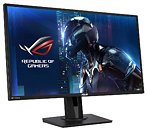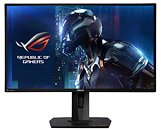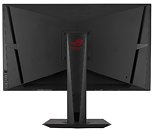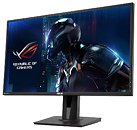Monday, March 25th 2019

ASUS Outs ROG Swift PG278QE: 27-inch WQHD with 165Hz
ASUS today rolled out the ROG Swift PG278QE, a 27-inch planar gaming monitor with stellar gaming-grade specifications. To begin with, you get WQHD (2560 x 1440 pixels) resolution, with 165 Hz refresh-rate, 1 ms (GTG) response time, and support for NVIDIA G-Sync. It also packs TÜV Rheinland-certified blue light reduction technology that reduces eye fatigue from extended gameplay sessions. ASUS did not mention panel type, however, looking at its 170°/160° (H/V) viewing-angles, we guess it could be TN-film based. Inputs include DisplayPort 1.2 and HDMI 1.4. The company didn't reveal pricing.





36 Comments on ASUS Outs ROG Swift PG278QE: 27-inch WQHD with 165Hz
Stellar dust....
1) Panel technology: IPS(must), VA(maybe), TN(no no)
2) Resolution
3) Refresh rate
4) Variable Refresh Rate (No G-Sync)
5) Size
6) Power comsumption
x) Other stuff
Dream Monitor: www.lg.com/us/monitors/lg-38GL950G-B-gaming-monitor
Hope they make a FreeSync version, but it will be probably way too expensive.
Most likely a wrong guess based on the previous model being IPS.
PG278QE with 170/160 viewing angles is definitely also TN.
If its purely performance, ya know, the people that run state of the art hardware but turn all graphics to as low as possible just to get as many frames per second as they can, then sure a TN panel would be fine.
For me however, I dont care much for that, I want it all to look good and with IPS's better colour space/reproduction etc, id rather have that.
You're correct,better to settle for a nice tn with good gamma control,i'm very satisfied with my acer predator.It's got nothing to do with your preferences.It's a great feature and if you put power consumption ovet ulmb you got your priorities wrong.
I'm not convinced adding an earphone jack accounts for that.
Note how ULMB/strobe is four times as 'fast' as a 120hz native render.
PG278QR was release in 2017 and was update to 165Hz. This model is inferior to the first version. It suffer from huge color banding and clouding issue. Also aggressive panel coating could be a deal breaker for many people (The first model only use medium coating).
I guess PG278QE may try to address the problem of PG278QR. The later 1440p 144-165Hz TN panel from AUO seem to be much better at banding than early model. For example the ASUS counterpart Dell S2716DG was also suffered from huge color banding issue on early revision. It was mostly fixed on A08 and later revision. Also Dell S2719DGF which continue to use TN from AUO is completely free from color banding issue.
PS. TN panel is not always bad. Once properly calibrated (2.2 Gamma / 6500K White Point / 120 cd/m^2) the colors can looks good especially on newer 8 bit TN. The remaining issue is still gamma shift but that is just a natural trait of TN. Also any blur reduction technology work best on TN. There is none to less strobe crosstalk compared to moderate crosstalk on IPS and severe crosstalk on VA.
When you buy a monitors you have to pick poison bottles anyways. I can't stand against black crush and slow response time on VA that cause ghosting / inverse ghosing / strobe crosstalk. While I can live with gamma shift on TN and moderate level of black light bleed / IPS glow. So it is only TN or IPS for me. In the end I choose TN because price different is big at that time. 1440p 144-165Hz G-Sync TN cost $500 here while I need to spend another $400 for the same specs but being IPS models.
But you're absolutely right otherwise, every panel tech is a trade off.
Cheers!
Without reading an in dept review, ULMB can either look:
very good — with beautiful CRT-style motion clarity, no microstutters, and no noticeable double images.
or
very bad — with distracting side effects such as double images (strobe crosstak), poor colors, very dim, very microstuttery, flickery.
Source: www.blurbusters.com/faq/motion-blur-reduction/
ULMB / strobe implementations do differ, as do all other monitor qualities. It just seems strange to omit a key feature for a high refresh rate display, because simply put, IPS without strobe can't even properly keep up with 144hz in G2G, all the high refresh gets you is more blur - or more ghosting from overdrive, which really looks about the same.
Strobe Crosstalk = Can't really do much on most monitor. Some that can adjust overdrive level may help reduce crosstalk. But most likely you will depend on panel type and manufacturer's mercy. The only blur reduction tech that allow user optimize to reduce crosstalk is BenQ DyAc. While ULMB is more like plug and play.
Poor colors = Not so much for modern blur reduction. This is not the day of Nvidia Lightboost. Gamma may skew a bit like from 2.2 to 2.3. Solution is calibrate monitor both normal mode and ULMB mode.
Very dim = On older models like PG278Q (2014) I would still say not likely. These old models still capable of hitting 120 cd/m^2. Should work find on most room unless you want to use monitor outdoor. On newer models like 1080p 240Hz TN G-Sync they can hit 250-275 cd/m^2. Overkill anyways.
Very microstuttery. Yes if you play unoptimized games that have poor / not smooth frametimes because in ULMB mode there is no "blur" to mask those stutter.
Flickery = depend. It is not as high as older monitor that don't use some kind of flicker free. This is personal preference. Some may OK with it while some may avoid it.